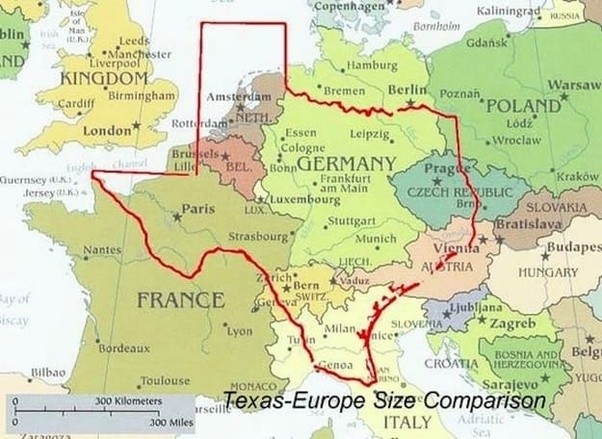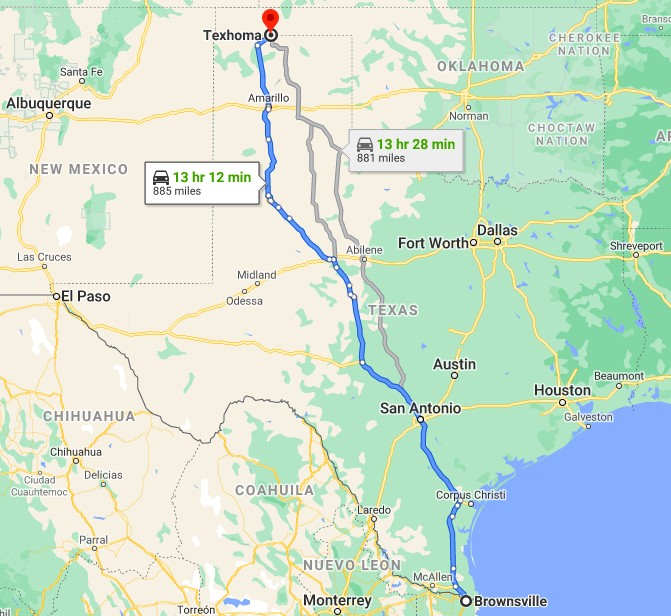Texas’s vastness is undeniable, but how does it stack up against Japan? This detailed comparison, brought to you by COMPARE.EDU.VN, explores the size, population, economy, and other interesting facts of both regions to provide a clear understanding. Discover the surprising differences and similarities between these two influential entities with insights into their geography, demographics, and economic power, helping you make informed decisions about travel, business, or further study.
1. Introduction: Texas vs. Japan – A Tale of Two Giants
The Lone Star State, Texas, is renowned for its expansive landscapes and robust economy, while Japan is celebrated for its technological advancements and rich cultural heritage. Comparing these two regions offers fascinating insights into their respective strengths and characteristics. In this comprehensive comparison, COMPARE.EDU.VN delves into the geographic, demographic, and economic aspects of Texas and Japan to provide a clear understanding of their relative sizes and significance.
2. Geographical Dimensions: How Does Texas Measure Up Against Japan?
When it comes to sheer land area, Texas significantly outweighs Japan.
2.1. Land Area Comparison
Texas boasts a land area of approximately 268,597 square miles (695,662 square kilometers). In contrast, Japan covers around 145,937 square miles (377,975 square kilometers). This means Texas is about 84% larger than Japan, almost twice its size.
2.2. Terrain and Topography
Texas features diverse terrain, from coastal plains and prairies to rolling hills and rugged mountains. The state’s topography varies widely, contributing to its ecological diversity. Japan, on the other hand, is predominantly mountainous, with limited plains and arable land. Its volcanic landscape and extensive coastline contribute to its unique geographical profile.
2.3. Coastline Length
While Texas has a coastline of approximately 367 miles (591 kilometers) along the Gulf of Mexico, Japan’s coastline stretches over 18,486 miles (29,751 kilometers) due to its archipelago nature. The extensive coastline has significantly influenced Japan’s maritime industries and cultural identity.
2.4. Agricultural Land
Despite its smaller size, Japan has a relatively high percentage of arable land compared to its total area. However, Texas possesses vast agricultural lands, supporting a diverse range of crops and livestock. The agricultural sector plays a crucial role in both economies, though their approaches and products differ significantly.
3. Demographic Dynamics: Population, Density, and Distribution
While Texas surpasses Japan in land area, the population dynamics present a different perspective.
3.1. Population Size
As of recent estimates, Japan has a population of approximately 125.8 million people, while Texas is home to around 29.2 million residents. This means Japan’s population is more than four times that of Texas.
3.2. Population Density
Given the smaller land area and larger population, Japan has a significantly higher population density than Texas. Japan averages around 340 people per square kilometer, whereas Texas has about 42 people per square kilometer.
3.3. Urban vs. Rural Distribution
Both Japan and Texas have a mix of urban and rural areas, but the distribution patterns vary. Japan’s population is concentrated in densely populated urban centers like Tokyo, Osaka, and Nagoya. Texas has major metropolitan areas like Houston, Dallas, and San Antonio, but also large expanses of rural land.
3.4. Demographic Trends
Japan faces challenges related to an aging population and declining birth rates, leading to concerns about future workforce and economic sustainability. Texas, on the other hand, experiences steady population growth, driven by factors such as job opportunities and migration.
4. Economic Engines: GDP, Industries, and Trade
The economic landscapes of Texas and Japan reflect their distinct geographic and demographic characteristics.
4.1. Gross Domestic Product (GDP)
Japan’s GDP is significantly larger than that of Texas. Japan’s GDP is around $5 trillion, while Texas has a GDP of approximately $2 trillion. This difference underscores Japan’s position as one of the world’s leading economies.
4.2. Key Industries
Japan is known for its advanced manufacturing, automotive, electronics, and technology industries. These sectors drive innovation and contribute significantly to the country’s economic output. Texas relies on industries such as oil and gas, agriculture, technology, and healthcare. The energy sector, in particular, plays a vital role in the state’s economy.
4.3. Trade and Commerce
Both Japan and Texas are active participants in international trade. Japan exports a wide range of goods, including automobiles, electronics, and machinery, to global markets. Texas exports petroleum and petroleum products, chemicals, computer and electronic products, and machinery.
4.4. Economic Growth and Stability
Japan has experienced periods of economic stagnation and faces challenges related to deflation and an aging population. Texas, in contrast, has generally demonstrated strong economic growth, driven by factors such as a favorable business climate and diverse industries.
5. Cultural Contrasts: Traditions, Innovation, and Lifestyle
The cultural landscapes of Japan and Texas are shaped by their unique histories, values, and societal norms.
5.1. Cultural Heritage
Japan is renowned for its rich cultural heritage, including traditions such as tea ceremonies, martial arts, calligraphy, and traditional arts. Texas boasts a blend of cultural influences, reflecting its history as part of Spain, Mexico, and the United States. Texan culture embraces aspects of music, cuisine, and cowboy traditions.
5.2. Technological Innovation
Japan is a global leader in technological innovation, known for its advancements in robotics, electronics, and automotive engineering. Texas has a growing technology sector, particularly in cities like Austin and Dallas, with strengths in software, biotechnology, and aerospace.
5.3. Lifestyle and Values
Japan emphasizes values such as harmony, respect, and diligence, which shape social interactions and business practices. Texas reflects values such as independence, self-reliance, and a strong work ethic, which influence its approach to business and community life.
5.4. Culinary Traditions
Japanese cuisine is celebrated worldwide for its emphasis on fresh ingredients, precise preparation techniques, and artistic presentation. Texas cuisine is known for its hearty portions, barbecue, chili, and Tex-Mex flavors.
6. Environmental Considerations: Sustainability and Conservation
The environmental challenges and conservation efforts in Japan and Texas reflect their distinct geographic and economic contexts.
6.1. Environmental Challenges
Japan faces environmental challenges related to pollution, resource management, and the impacts of natural disasters such as earthquakes and tsunamis. Texas grapples with issues such as water scarcity, air pollution, and the environmental effects of oil and gas production.
6.2. Conservation Efforts
Japan has implemented various conservation initiatives, including reforestation programs, efforts to protect endangered species, and regulations to control pollution. Texas has initiatives focused on water conservation, land preservation, and renewable energy development.
6.3. Renewable Energy Adoption
Both Japan and Texas are investing in renewable energy sources to reduce reliance on fossil fuels and mitigate climate change. Japan is promoting solar, wind, and geothermal energy, while Texas is a leader in wind power generation and is expanding its solar energy capacity.
6.4. Urban Planning and Sustainability
Japan is known for its efficient urban planning, compact cities, and extensive public transportation networks, which contribute to sustainability. Texas faces challenges related to urban sprawl, traffic congestion, and the need for more sustainable urban development practices.
7. Travel and Tourism: Exploring Japan and Texas
Both Japan and Texas offer unique travel experiences, attracting visitors with their diverse attractions and cultural offerings.
7.1. Tourist Attractions in Japan
Japan boasts a wealth of tourist attractions, including ancient temples, scenic gardens, bustling cityscapes, and ski resorts. Popular destinations include Tokyo, Kyoto, Hiroshima, and Mount Fuji.
7.2. Tourist Attractions in Texas
Texas offers a diverse range of attractions, from historic sites and museums to natural parks and entertainment venues. Popular destinations include San Antonio’s River Walk, the Alamo, Big Bend National Park, and the Space Center Houston.
7.3. Travel Infrastructure
Japan has a highly developed transportation infrastructure, including efficient bullet trains, extensive subway systems, and well-maintained highways, making it easy to travel throughout the country. Texas has a robust highway system and several major airports, but public transportation options are more limited compared to Japan.
7.4. Cultural Experiences
Japan offers unique cultural experiences such as tea ceremonies, kimono rentals, and visits to traditional festivals and sumo wrestling matches. Texas provides opportunities to experience its unique cultural heritage through rodeos, live music venues, and historical reenactments.
8. Key Differences Between Japan and Texas
To summarize, here’s a quick comparison between Japan and Texas:
| Feature | Japan | Texas |
|---|---|---|
| Land Area | 145,937 sq mi (377,975 sq km) | 268,597 sq mi (695,662 sq km) |
| Population | 125.8 million | 29.2 million |
| GDP | $5 trillion | $2 trillion |
| Key Industries | Manufacturing, Technology, Automotive | Oil & Gas, Agriculture, Technology |
| Population Density | High | Low |
| Culture | Traditional, High-Tech | Blend of American and Hispanic |
| Environment | Pollution, Natural Disasters | Water Scarcity, Air Pollution |


9. How Many States Can Fit In Texas?
Texas is so large that it can accommodate several smaller states within its borders. Fifteen of the smallest U.S. states could fit within Texas simultaneously, including Kentucky, Virginia, Indiana, Maine, South Carolina, West Virginia, Maryland, Vermont, New Hampshire, Massachusetts, New Jersey, Hawaii, Connecticut, Delaware, and Rhode Island. Individually, every state except for Alaska can fit in Texas. California, the third-largest state, can fit into Texas about 1.6 times, and Rhode Island, the smallest state at only 1,212 square miles, can fit into Texas approximately 221 times.
10. Fun Facts About Texas Size
- The entire world population of 7.8 billion could fit into the state of Texas, assuming the population density of New York City of 27,000 per square mile.
- If Texas were its own country, it would be the 40th largest out of 193 countries in the world, bigger than every country in Europe.
- King Ranch, the largest ranch in Texas and the U.S., spans 1,289 square miles—larger than the state of Rhode Island.
- The fastest road in the United States is in Texas, a 40-mile stretch from Austin to San Antonio with an 85 mph speed limit.
- El Paso is closer to Denver (637 miles) than to Houston (747 miles).
- El Paso, Texas, is closer to the Pacific Ocean at San Diego, California, than to Texarkana, Texas.
- The “Texas Triangle” (Dallas, Fort Worth, Houston, Austin, and San Antonio) houses over 21 million of Texas’s 30.5 million residents.
- Dallas/Fort Worth Airport, at 27 square miles, is larger than the island of Manhattan.
- U.S. 83, the longest highway in Texas, stretches 783.5 miles from Perryton on the Oklahoma border to Brownsville on the Mexican border.
- Texas boasts the U.S.’s largest domed state capitol building with 18 acres of floor space.
11. Driving Across Texas: A Long Journey
Driving across Texas requires significant time due to its vast size. It takes approximately 11 hours to drive 773 miles from east to west. Starting in El Paso and driving east on I-10, then taking I-20 through Odessa, Abilene, and the Dallas-Ft. Worth Metroplex to Waskom, near the Texas-Louisiana border. A north-to-south drive covering 805 miles from Texhoma to Brownsville takes around 13 hours, with stops in Lubbock and San Antonio.
12. The Economic Impact of Texas and Japan
Both Texas and Japan boast significant economies that impact global markets. Japan, a global leader in technology and automotive industries, exports worldwide. Texas, rich in oil and gas, plays a crucial role in the U.S. energy sector. Their contributions to international trade and innovation are substantial.
13. Is Texas Bigger Than France?
Yes, Texas is about 8% larger than France. The Texas land mass is 268,597 square miles, while France covers 248,573 square miles. France has a population of about 67.4 million people, which is more than double the population of Texas at 29.3 million people. Economically, France is just 23% larger with a GDP of $2.9 trillion compared to Texas’s $2 trillion GDP.
14. Is Texas Bigger Than Germany?
Texas is almost twice as big as Germany. Texas, at 268,597 square miles, is approximately 94.5% larger than Germany, which covers 138,065 square miles. Germany has a population of 83.2 million, about 2.84 times larger than Texas at 2.9 million. The GDP of Germany is $3.8 trillion, roughly 90% larger than the Texas GDP at $2 trillion.
15. Is Texas Bigger Than The UK?
Yes! At 268,597 square miles, Texas is about 2.8 times larger than the UK, which measures only 93,628 square miles. With 67.2 million people, the population of the UK is about 2.3 times larger than Texas, with 29.2 million residents. The UK’s GDP, at $2.7 trillion, is approximately 35% larger than Texas’s $2 trillion.
16. Comparative Analysis: Texas vs. Japan in Key Sectors
| Sector | Texas | Japan |
|---|---|---|
| Energy | Dominant in oil and gas production, increasing renewable energy focus | Heavily reliant on imported energy, strong focus on efficiency and nuclear |
| Technology | Growing tech sector, especially in Austin and Dallas | Global leader in electronics, robotics, and automotive technology |
| Agriculture | Large-scale agriculture, significant livestock production | Smaller-scale, intensive agriculture due to limited arable land |
| Manufacturing | Strong manufacturing base, particularly in petrochemicals and aerospace | World-renowned for high-quality manufacturing, especially automobiles and electronics |
| International Trade | Significant exports of petroleum products, chemicals, and technology | Major exporter of automobiles, electronics, and machinery |
17. Future Trends: What Lies Ahead for Texas and Japan?
Both Texas and Japan face unique challenges and opportunities in the coming years.
17.1. Japan’s Future Outlook
Japan needs to address its aging population, declining birth rates, and economic stagnation. Focus on technological innovation, healthcare, and sustainable practices will be crucial for future growth.
17.2. Texas’s Future Outlook
Texas is expected to continue its population and economic growth, but needs to manage urban sprawl, water scarcity, and infrastructure development. The shift towards renewable energy and diversification of its economy will be essential.
18. Frequently Asked Questions (FAQ)
18.1. Is Texas bigger than Japan?
Yes, Texas is about 84% larger than Japan.
18.2. What is the population of Texas compared to Japan?
Japan has a population of approximately 125.8 million, while Texas has around 29.2 million.
18.3. How does the GDP of Texas compare to Japan?
Japan’s GDP is approximately $5 trillion, while Texas has a GDP of around $2 trillion.
18.4. Which state is closer in size to Japan?
No state in the US is close to the size of Japan. Texas is almost twice the size of Japan.
18.5. What are the main industries in Texas?
Oil and gas, agriculture, technology, and healthcare.
18.6. What are the main industries in Japan?
Manufacturing, automotive, electronics, and technology.
18.7. How long does it take to drive across Texas?
It takes approximately 11 hours to drive east-west and 13 hours to drive north-south.
18.8. What are some popular tourist attractions in Texas?
San Antonio’s River Walk, the Alamo, Big Bend National Park, and the Space Center Houston.
18.9. What are some popular tourist attractions in Japan?
Tokyo, Kyoto, Hiroshima, and Mount Fuji.
18.10. How does the population density of Texas compare to Japan?
Japan has a much higher population density than Texas, averaging around 340 people per square kilometer compared to Texas’s 42 people per square kilometer.
19. Conclusion: Understanding the Scale and Scope
In conclusion, while Texas is significantly larger than Japan in land area, Japan surpasses Texas in population and GDP. Both regions have distinct cultural, economic, and environmental characteristics that shape their unique identities. Whether you’re planning a trip, conducting business, or simply curious about these two dynamic regions, understanding their differences and similarities provides valuable insights.
Navigating the vast landscape of comparisons can be daunting, but COMPARE.EDU.VN is here to help. We offer detailed and objective comparisons across a wide range of topics to help you make informed decisions.
Ready to explore more comparisons? Visit compare.edu.vn at COMPARE.EDU.VN today! Our address is 333 Comparison Plaza, Choice City, CA 90210, United States. Contact us via Whatsapp at +1 (626) 555-9090. Let us help you make the best choices!
